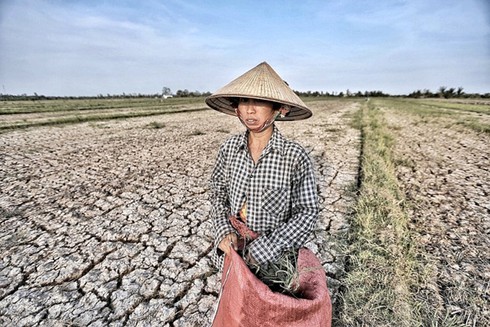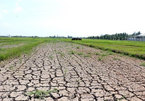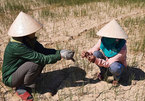as a result of global warming, lethal heatwaves, droughts, floods, and typhoons.
 |
| By 2025, 8-13% of Asian countries' GDP could be at risk due to climate change. Photo: UNDPClimate |
In its report titled "Climate risk and response in Asia", McKinsey shows that COVID-19 is highlighting the importance of risk and resilience, and as the world focuses on recovery, it is important to not lose sight of climate risk.
The Earth’s climate is changing after more than 10,000 years of relative stability, and Asia is on the front line.
Absent adaptation and mitigation, the climate hazards the region faces in the future (from heat waves to flooding) are likely to be more severe and more intense.
Indeed, the impacts in Asia in some cases could be more severe than in many other parts of the world.
As Asia seeks to grow its economy – and remain a key source of growth for the world – climate is a critical challenge that the region will need to manage. Asia is also well positioned to address these challenges and capture the opportunities that come from managing climate risk effectively.
Infrastructure and urban areas are still being built out in many parts of Asia, which gives the region the chance to ensure that what goes up is more resilient and better able to withstand heightened risk.
Like all parts of the world, Asia can also contribute to reducing emissions. Climate science noted that further warming will continue until net zero emissions are reached.
If policymakers and business leaders can harness the region’s innovative spirit, talent, and flexibility, Asia could lead a global response to climate risk by adapting and mitigating the most severe potential consequences.
Asia faces a range of climate hazards, with potentially different impacts depending on geography.
Already, climate scientists find evidence of the growing effect of climate change on the likelihood and intensity of extreme events. For example, in China, the 2017 floods in Hunan province affected 7.8 million people and resulted in US$3.55 billion of direct economic loss, including severe infrastructure damage.
Researchers have examined the likelihood of fires in Australia and found that the risk of weather conditions that result in fires as severe as observed in 2019-2020 (measured with a so-called Fire Weather Index) has increased by at least 30% since 1900.
In the high-emissions Representative Concentration Pathway (RCPs) 8.5 scenario considered in the report, climate science predicts significant temperature increases across Asia and conditions of rising heat and humidity in many parts of the continent. More than 75% of global capital stock that could be damaged from riverine flooding in a given year is in Asia.
Experts at McKinsey translated the hazards into socio-economic impacts across a range of systems. As noted, socio-economic impacts include five systems: livability and workability, food systems, physical assets, infrastructure services, and natural capital.
The socio-economic impacts of these physical changes are nonlinear: once hazards exceed certain thresholds, the affected physiological, human-made, or ecological systems work less well or break down and stop working altogether.
This is because the systems have evolved or been optimised over time for historical climates. Rising heat and humidity levels, for example, could affect the human body’s ability to work outdoors and also the survivability of healthy human beings.
The knock-on effects can be systemic, because direct impacts in a particular geography could spread and have cascading impacts.
For instance, in Vietnam's Ho Chi Minh City, where direct infrastructure damage from a 100-year flood could be between US$500 million and US$1 billion by 2050, knock-on costs could be between US$1.5 billion and US$8.5 billion.
McKinsey analysis finds that the socio-economic impacts from intensifying climate hazards could in many cases be more severe for Asia than for other parts of the world, in the absence of adaptation and mitigation.
Under RCP 8.5, by 2050, between 600 million and one billion people in Asia will be living in areas with a nonzero annual probability of lethal heat waves. This compares with a global total of 700 million to 1.2 billion; in other words, a substantial majority of these people are in Asia.
By 2050, on average, between US$2.8 trillion and US$4.7 trillion of GDP in Asia annually will be at risk from a loss of outdoor working hours because of increased heat and humidity; that accounts for more than two-thirds of the total annual global GDP impact.
Finally, about US$1.2 trillion in capital stock in Asia could be damaged by riverine flooding in a given year by 2050, equivalent to about 75% of the global impact.
Emerging Asia in McKinsey’s analysis consists of Cambodia, Indonesia, Laos, Malaysia, Myanmar, the Philippines, Thailand, and Vietnam.
These culturally diverse countries see a high share of regional trade, capital, and people flows, and are a major source of labour. Like Frontier Asia (India, Bangladesh, Pakistan), they are expected to see increases in heat and humidity.
By 2050, in an average year, between 8 and 13% of GDP could be at risk as a result of rising heat and humidity. The region could also experience growing exposure to extreme precipitation events and flooding. The socio-economic impacts of these hazards could potentially be severe. Capital stock at risk from riverine flooding in Frontier Asia countries is expected to double from 0.7% today to 1.5% by 2050, or US$220 billion.
Drought could become less frequent in this region. Agriculture yields could see increased volatility here. In agriculture crop yield, annual probability of a 10% yield decline will increase 2% today to 8% by 2050. At the same time, annual probability of a 10% yield increase will decrease from 5% today to 1% by 2050.
Another characteristic of climate risk is its regressive nature; the poor will be hit hardest. While different parts of Asia are affected differently, countries with lower levels of per capita GDP are probably most at risk from the impacts of climate change.
They are often exposed to climates that are closer to physical thresholds than those of wealthier countries. They rely more on outdoor work and natural capital and have fewer financial means to adapt.
Both of these sets of countries (Frontier and Emerging Asia) face potentially disproportionate impacts on workability from extreme heat and humidity. By 2050, under RCP 8.5 scenario, some 7 to 13% of GDP in Frontier Asia and Emerging Asia could be at risk.
This compares to 0.6-0.7% for Advanced Asia (Australia, New Zealand, Japan, the Republic of Korea). The regressive impacts of climate change, if allowed to proceed without adaptation or mitigation, thus could put the Asian growth story at risk and potentially affect the lives and livelihoods of millions. VIR

Mobilising community resources for climate change actions one of VN's priorities
Head of the Ministry of Natural Resources and Environment's Climate Change Department Tang The Cuong talks about the national plan on climate change adaptation for 2021-30, with a vision towards 2050.

Vietnamese Government plan aims to improve adaptation to climate change
Enhancing State management of climate change is one of the major measures in the national plan on climate change adaptation for 2021-2030, with a vision towards 2050, recently issued by Prime Minister Nguyen Xuan Phuc.